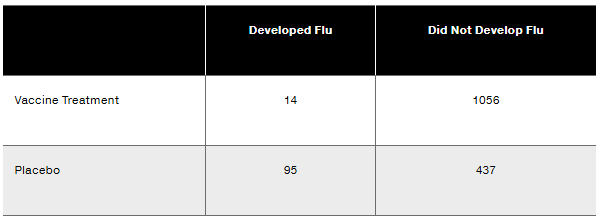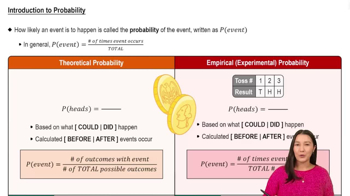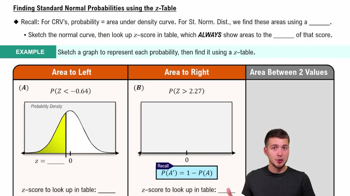Penicillin “Who discovered penicillin: Marcel Bich, William Penn, Jonas Salk, Alexander Fleming, or Louis Pasteur?” If you make a random guess for the answer to that question, what is the probability that your answer is the correct answer of Alexander Fleming?
Table of contents
- 1. Intro to Stats and Collecting Data1h 14m
- 2. Describing Data with Tables and Graphs1h 55m
- 3. Describing Data Numerically2h 5m
- 4. Probability2h 16m
- 5. Binomial Distribution & Discrete Random Variables3h 6m
- 6. Normal Distribution and Continuous Random Variables2h 11m
- 7. Sampling Distributions & Confidence Intervals: Mean3h 23m
- Sampling Distribution of the Sample Mean and Central Limit Theorem19m
- Distribution of Sample Mean - Excel23m
- Introduction to Confidence Intervals15m
- Confidence Intervals for Population Mean1h 18m
- Determining the Minimum Sample Size Required12m
- Finding Probabilities and T Critical Values - Excel28m
- Confidence Intervals for Population Means - Excel25m
- 8. Sampling Distributions & Confidence Intervals: Proportion1h 25m
- 9. Hypothesis Testing for One Sample3h 29m
- 10. Hypothesis Testing for Two Samples4h 50m
- Two Proportions1h 13m
- Two Proportions Hypothesis Test - Excel28m
- Two Means - Unknown, Unequal Variance1h 3m
- Two Means - Unknown Variances Hypothesis Test - Excel12m
- Two Means - Unknown, Equal Variance15m
- Two Means - Unknown, Equal Variances Hypothesis Test - Excel9m
- Two Means - Known Variance12m
- Two Means - Sigma Known Hypothesis Test - Excel21m
- Two Means - Matched Pairs (Dependent Samples)42m
- Matched Pairs Hypothesis Test - Excel12m
- 11. Correlation1h 6m
- 12. Regression1h 50m
- 13. Chi-Square Tests & Goodness of Fit1h 57m
- 14. ANOVA1h 57m
4. Probability
Basic Concepts of Probability
Problem 4.q.6
Textbook Question
In Exercises 6–10, use the following results from tests of an experiment to test the effectiveness of an experimental vaccine for children (based on data from USA Today). Express all probabilities in decimal form.

If 1 of the 1602 subjects is randomly selected, find the probability of getting 1 that developed flu.
 Verified step by step guidance
Verified step by step guidance1
Step 1: Begin by identifying the total number of subjects in the experiment. Add all the values in the table: 14 (Developed Flu, Vaccine Treatment) + 1056 (Did Not Develop Flu, Vaccine Treatment) + 95 (Developed Flu, Placebo) + 437 (Did Not Develop Flu, Placebo).
Step 2: Calculate the total number of subjects who developed flu. Add the values from the 'Developed Flu' column: 14 (Vaccine Treatment) + 95 (Placebo).
Step 3: To find the probability of randomly selecting a subject who developed flu, divide the total number of subjects who developed flu (from Step 2) by the total number of subjects in the experiment (from Step 1).
Step 4: Express the probability as a decimal. Ensure the division result is rounded appropriately if necessary.
Step 5: Interpret the result. The probability represents the likelihood of randomly selecting a subject who developed flu from the entire group of 1602 subjects.
 Verified video answer for a similar problem:
Verified video answer for a similar problem:This video solution was recommended by our tutors as helpful for the problem above
Video duration:
1mPlay a video:
Was this helpful?
Key Concepts
Here are the essential concepts you must grasp in order to answer the question correctly.
Probability
Probability is a measure of the likelihood that a particular event will occur, expressed as a number between 0 and 1. In this context, it refers to the chance of randomly selecting a subject who developed the flu from the total number of subjects. The probability can be calculated by dividing the number of favorable outcomes (subjects who developed flu) by the total number of outcomes (total subjects).
Recommended video:

Introduction to Probability
Experimental Design
Experimental design refers to the framework for conducting an experiment, including how subjects are assigned to treatment groups. In this case, the subjects are divided into two groups: those receiving the vaccine treatment and those receiving a placebo. Understanding the design helps in interpreting the results and assessing the effectiveness of the vaccine.
Recommended video:

Introduction to Probability
Contingency Table
A contingency table is a data representation that displays the frequency distribution of variables, allowing for the analysis of the relationship between them. The provided table shows the number of subjects who developed or did not develop flu under two different treatments (vaccine and placebo). This format aids in calculating probabilities and understanding the impact of the vaccine.
Recommended video:
Guided course

Finding Standard Normal Probabilities using z-Table

 5:37m
5:37mWatch next
Master Introduction to Probability with a bite sized video explanation from Patrick
Start learningRelated Videos
Related Practice
Textbook Question
